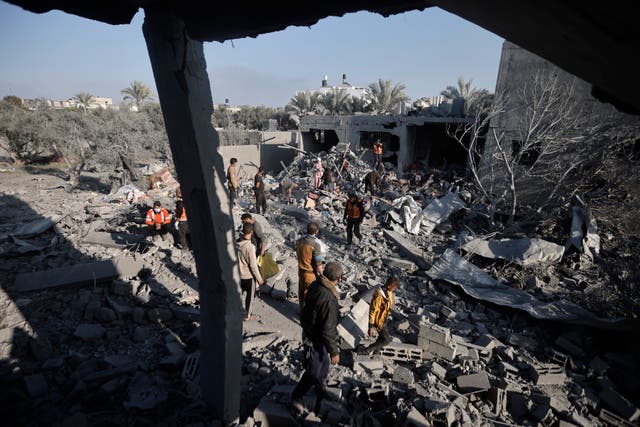The Israeli military confirmed that it was pulling thousands of troops out of the Gaza Strip, a step that could clear the way for a new long-term phase of lower-intensity fighting against the Hamas militant group.
The confirmation of the planned troop drawdown came the same day that Israel’s Supreme Court struck down a key component of prime minister Benjamin Netanyahu’s judicial overhaul plan.
While the plan is not directly connected to the war effort, it was the source of deep divisions inside Israel and had threatened the military’s readiness before the October 7 Hamas attack that triggered the ongoing war.
Politicians warned against reigniting those divisions and harming the national unity that has prevailed throughout the Israel-Hamas war.

Mr Netanyahu has vowed to press ahead with the military offensive until Hamas is crushed and the more than 100 hostages still held by the militant group in Gaza are freed.
But Israel has come under growing international pressure to scale back an offensive that has led to the deaths of nearly 22,000 Palestinians.
US secretary of state Antony Blinken, who has repeatedly urged Israel to do more to protect Palestinian civilians, is expected in the region next week.
In its announcement, the army said that five brigades, or several thousand troops, would be taken out of Gaza in the coming weeks.
Some will return to bases for further training or rest, while many older reservists will go home.
The war has taken a toll on the economy by preventing reservists from going to their jobs, running their businesses or returning to university studies.
The army’s chief spokesman, Rear Admiral Daniel Hagari, did not say whether the withdrawal of some troops reflected a new phase of the war.

“The objectives of the war require prolonged fighting, and we are preparing accordingly,” he told reporters late on Sunday.
But the move is in line with the plans that Israeli leaders have outlined for a low-intensity campaign, expected to last for much of the year, that focuses on remaining Hamas strongholds and “pockets of resistance.”
Israel has said it is close to operational control over most of northern Gaza, reducing the need for forces there.
Yet fierce fighting has continued in other areas of the Palestinian territory, especially the south, where many of Hamas’ forces remain intact and where most of Gaza’s 2.3 million people have fled.
Israel has vowed to crush Hamas’ military and governing capabilities in the ongoing war, which was sparked by the militant group’s October 7 attack on southern Israel in which 1,200 people were killed and 240 others were taken hostage.
Israel responded with an air, ground and sea offensive that has killed more than 21,900 people in Gaza, two-thirds of them women and children, according to the Health Ministry in the Hamas-ruled territory, which does not differentiate between civilians and combatants in its count.
The Israeli military says 173 soldiers have died since it launched its ground operation.
Israel also says, without providing evidence, that more than 8,000 militants have been killed.
It blames Hamas for the high civilian death toll, saying the militants embed within residential areas, including schools and hospitals.
The war has displaced some 85% of Gaza’s population, forcing tens of thousands of people in overcrowded shelters or teeming tent camps in Israeli-designated safe areas that the military has nevertheless bombed.
Palestinians are left with a sense that nowhere is safe.

With tensions high across the region, the United States announced on Monday that it would send an aircraft carrier strike group home and replace it with an amphibious assault ship and accompanying warships.
In Khan Younis, a city in southern Gaza that Israel says is a key Hamas stronghold, residents reported air strikes and shelling in the west and centre of the city.
Combat was also reported in urban refugee camps in central Gaza, where Israel expanded its offensive last week.
A reporter saw at least 17 bodies, including those of four children, at a hospital in the central town of Deir al-Balah after a missile struck a house.
“It’s our routine: bombings, massacres and martyrs,” said Saeed Moustafa, a Palestinian from the Nuseirat camp.
Gaza’s Health Ministry said that 156 people had been killed in the past day.
Meanwhile, Palestinian health workers are vaccinating children in Gaza’s southern city of Rafah, where hundreds of thousands have fled to escape the bombings.
Unicef said last week it delivered at least 600,000 doses of vaccines to the besieged enclave as illness spreads rapidly. The agency estimated that more than 16,600 infants have missed one or more routine vaccinations.
The Israeli military said an airstrike killed Adel Mismah, a regional commander of Hamas’ elite Nukhba forces, in Deir al-Balah.
In Israel, Kibbutz Be’eri, one of the communities hit by Hamas on October 7, announced that Ilan Weiss, who was thought to have been kidnapped, is now believed to be dead.
Mr Weiss’ daughter, Noga Weiss, 18; and wife, Shiri Weiss, 53; were held in captivity in Gaza and released on November 25 during a weeklong ceasefire.




Comments: Our rules
We want our comments to be a lively and valuable part of our community - a place where readers can debate and engage with the most important local issues. The ability to comment on our stories is a privilege, not a right, however, and that privilege may be withdrawn if it is abused or misused.
Please report any comments that break our rules.
Read the rules here